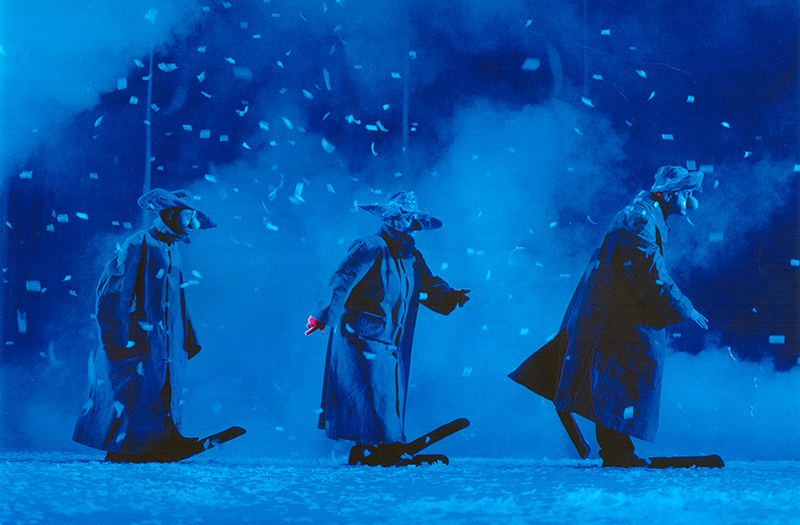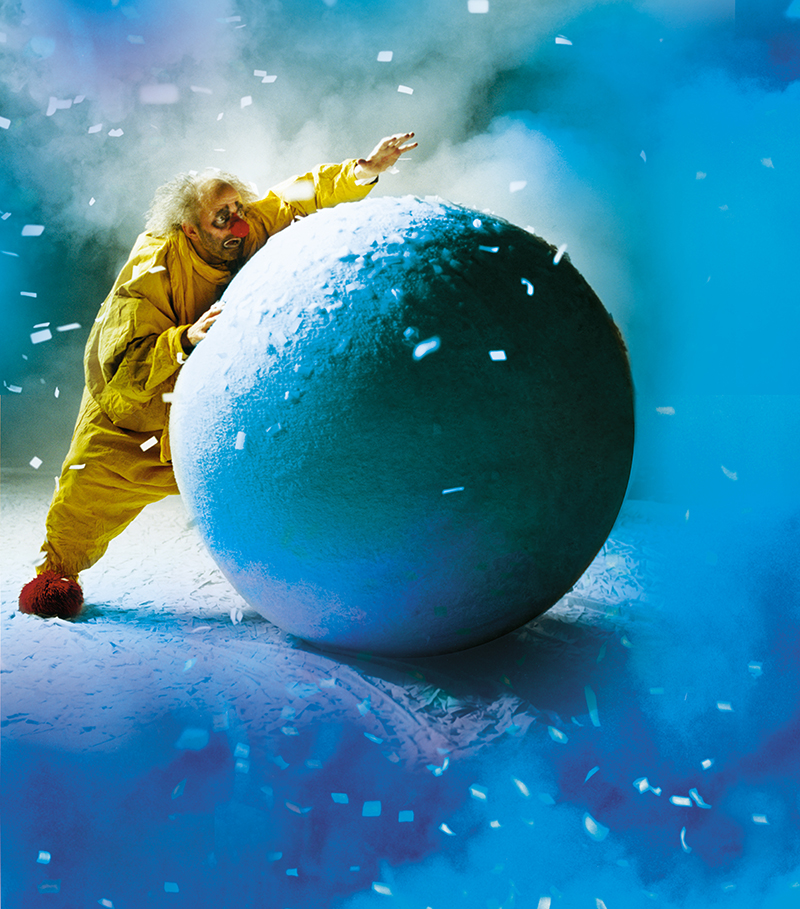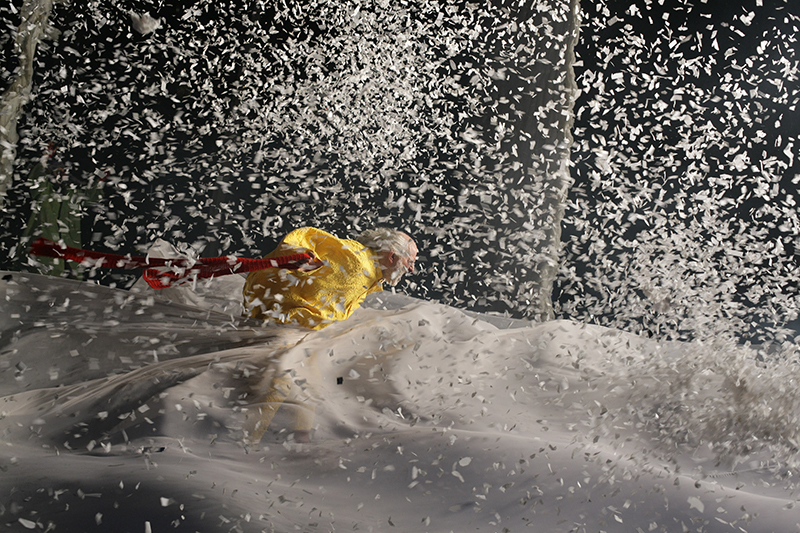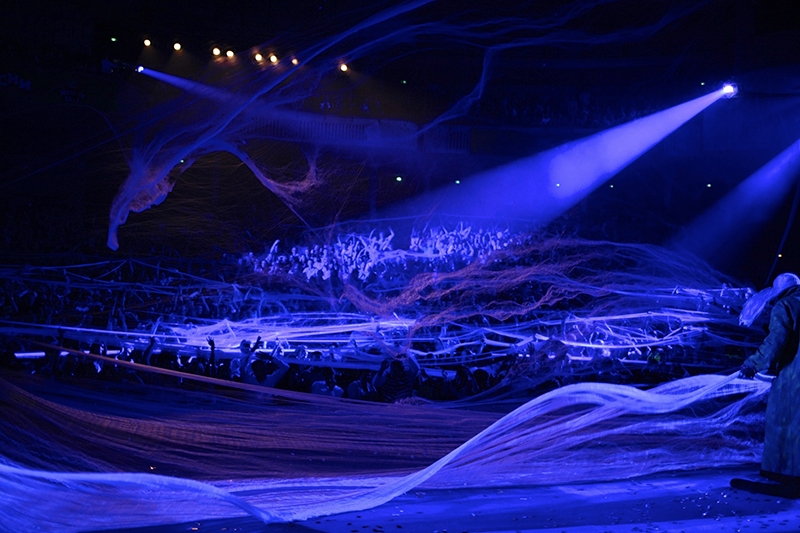
It’s funny to think that New Yorkers would brave the cold of late fall and early winter to witness the indoor spectacle of Slava’s Snowshow at the Stephen Sondheim Theatre on Broadway. But they come in droves to watch Slava and his clown troupe enact various vignettes, some of which elicit audience participation. As creator/co-scenic designer/ringmaster Slava Polunin notes when speaking to PLSN through Russian translator Maria Lentsman: “People say our snow really warms their hearts.”
The show really does speak to one’s inner child.

Snowballing Impact
Since 1992, Slava’s Snowshow has played in 52 countries and today performs 400 shows every year. They are used to working very fast in terms of doing load-in and set-up themselves, but upon arriving at the Stephen Sondheim Theatre, “we were given the luxury of working for a long time and the luxury of not having to do it ourselves,” says Polunin, who has a hand in all production aspects of the show. “That’s a first. Then, of course, the European standards of fireproofing are very different from what you might find on Broadway, so we had to deal with that.” He points out that the fire code issues are not about which one is stronger; it is just that the criteria are different.
“We have our producers to thank, because they withstood the hardest examinations on the part of the Fire Department,” adds Polunin, noting that the production passed with “flying colors. They helped look for a solution for every challenge that we encountered.”
Another change with coming to Broadway is that it gave Slava’s troupe an opportunity to create a bigger event than they had previously in New York, which also included increasing the number of actors on stage. “This has required re-choreographing all of the scenes,” says Polunin. “One of the changes is that being on Broadway, the show becomes more epic and has more space to also create its’ meaning.” He adds that about 20 percent of the show is improvisation every night, so there is always something new for the audience.
Floppy Ears and Shoes
The two-act Snowshow is made up of a variety of scenes featuring Slava and his floppy-eared, floppy-shoed clowns. Two clowns sail along the ocean while a shark circles them. Many crisscross the stage at various points and must tilt their heads lest their long hat ears collide. A hammy clown pierced by foam arrows stages an extended death scene that, at our show at least, includes falling into the audience, spraying them with someone’s bottled water, snatching someone’s purse, then writhing back onstage to milk the pathos. In a quieter moment, a forlorn Slava shares an intimate hug with a hung overcoat that he animates with his right arm. Then there are those wintry wonderland moments, with confetti snow swirling onstage, offstage and, at the show’s climax, pummeling the audience with an amazing indoor blizzard.
Some interesting statistics for the show: The average length of a green clown’s shoe from the heel is 1 meter 10 centimeters, which is around 3.5 feet. (“The large size shoes are directly proportional to their inability to understand anything.”) Approximately 96,000 rainbow bubbles are produced every night by bubble machines just off-stage on both sides. More than 3 million confetti snowflakes are used for every show.
A very noticeable scenic element in the show are foam backdrops that are hung across the stage to form an arctic-like background, although one or two are used to form the front of a ship at one point. They are hung from one point on strong wire. “That’s the point of ligature,” says Polunin, “and they can move in any direction.” They appear to have an open foam side on the back that gives the impression they look comfortable enough to sleep in. Evidently, that’s true.
“Because we are a nomadic tribe of actors, we needed to make sure that when we did not have a place to sleep, every member of the cast and crew has a fuzzy blanket to wrap up in,” explains Polunin. “These are, in fact, blankets. They’re very durable. You can wrap yourself up in the starry night sky, or, if you so wish, you can wrap yourself up in snowy wilderness and endless infinity of snow. Those blankets come in handy. Their weight has been calculated so that even the most frail of our technicians can easily wrap themselves into one of them. The very special hue [on the front side] is a Royal Blue that is only made an India.”

A Dash of Salt
There seems to be a bit of “artistic license” in that statement. One thing that was a concern prior to this interview was revealing anything that Slava considered to be a trade secret, so when reading his answers below about more technical aspects of the show, take them with a grain of salt. But they are fun.
One of the most memorable moments in the Snowshow comes at the end of the first act, when Slava and his clowns roll out a spider web-like material that the audience pulls along so they are eventually covered in it from the stage to the rear of the auditorium. The web has some of the consistency of cotton candy and slowly breaks up as it gets pulled across the audience. (I found a couple of wispy strands on my shirt the next day.) This scene certainly epitomizes the idea of “immersive theater.”
When asked about what the web is made of, Slava provides a cheeky, creative answer. “At first, we were using the web of silkworms from China,” he explains. “We have since moved on to a denser material, which is made in Brazil by spiders that are the size of a hand.” (The species? Megaviscosum hominemcapturam.) “There are plantations of spiders like that, so we do have to swing by every now and again to check on them. We have moved to really high tenacity, ultra-strong spider production. It’s very environmentally friendly as well, and it’s fair trade. Everything is natural and organic, and truly nothing in life is forever. Except for thoughts.”

An Intense Finale
The grand finale of the show is an intense blizzard of confetti that gets blasted out into the audience, most dramatically covering the orchestra seats, while people are blinded by a small wall of lights in the background. Appropriately enough, “O Fortuna” from Carl Orff’s Carmina Burana blasts through the speakers. While you can make out what the stage looks like in photos, the effect is overwhelming in the venue. It’s impossible to look straight ahead without shielding your eyes. You really do feel like you’re caught in a blizzard — okay, without the wetness or freezing temperatures.
“We will say that our wind generator is indeed unique,” teases Polunin. “It’s the only one of its kind, and the Japanese have actually purchased rights from us to be able to produce them industrially. For the humanity at large.”
Regardless of what wind machine is being used, there have to be safety considerations for creating the blizzard, even if it is simply confetti being shot out. They have tested the wind generator “over 3,000 times in a variety of climatic zones, time zones and variety of humidities,” says Polunin. “Of course, a lot depends on the mood of the person blasting them out on, whether the AC is on, whether the audience is sitting very closely together, whether the seating is more free, whether alcohol is sold at the bar, which really contributes to the blasting out of the snow. We have also tumbled the wind generator down a big mountain to see how many turns it can stand.”
Kidding aside, audience members are not allowed to bring food and drink into the venue. They can enjoy concessions outside, but not within. It makes sense because that blizzard blast is strong enough that things could get spilled within the first few rows, and they could also get confetti contaminating them.
In a list of “Remarkable Facts Technical and Poetic” provided to PLSN, I learned that the confetti is created at a special, unnamed factory in California and that “the shape, weight and thickness of the confetti have been specially designed in Britain to achieve the optimum effect simulating a fluttering butterfly.” Further, New Scientist magazine scientifically tested the confetti “to prove that it reaches to utmost results.” (See plsn.me/confetti-test.)
Thankfully, the confetti is biodegradable and non-combustible, which is important considering that 3 million “snowflakes” are used per show, not to mention a few big bags of confetti that get dumped on some people’s heads during the chaotic opening of the second act. (It can’t be fun for the theatre’s crew to clean up that mess after every performance.)
That second act showstopper features the clowns coming out into the audience, climbing across seats and rows, splattering some people with water and generally delighting the crowd with their antics. “We have noticed that a beloved child has the right to climb on his father’s head and tear out [his] hair,” says Polunin. “So the first half of the show, we are really trying to become the beloved child of the audience, and then it’s only after that we climb on top of people’s heads and start to tear out their hair.” But there are some people who are still wary of these clowns. “If we do see terror in someone’s eyes, we do avoid them and step back and not touch them.”
Following the clowns’ curtain bow, balloons and giant rubber balls are tossed into the audience for them to bat around, which keeps people occupied for at least 10 more minutes. “The biggest ones are four meters in diameter,” says Polunin. “The smaller ones are two and a half. But when we do work in bigger houses — in Colombia, for instance, we had a theater that seated 3,500 people — we let out six meter balls.”
While the balls are heavy, they do not cause injuries. At my show, I noticed a couple of unsuspecting people get bonked on the head because they were looking the other way. “The bigger the ball, the less hard it hits,” notes Polunin. “Because the contra movement of the air is bigger when the ball is bigger, it actually lands softer and less hard.”

Audience Participation
Although Slava’s Snowshow seems like a series of both whimsical and heartfelt vignettes, there is more behind it. “I just wanted, for clowning, to have a show that is not just funny, but that in some way is actually close to The Tempest by William Shakespeare,” reveals Polunin.
Initially, Slava created a plot, and then he “tore it all down and mixed it all up,” says Polunin. “A lot of the pleasure that the audience gets from seeing the show is the opportunity to co-create the show together with us and to finish the storyline, to think of ways that this could resolve, that this could flow into meaning. Today’s public want to participate in creation in art, and I give them this opportunity.”


